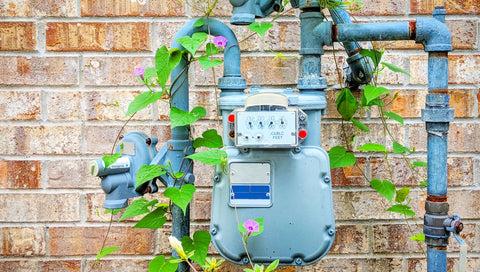A common issue that any gardener or homeowner will likely run into one day is the problem of a leaky spigot. This can present as a small, insignificant issue, but if left untouched for long enough, even an outdoor faucet leaking gently can cause serious damage to your garden, your house’s foundation and your bank account. Luckily, a leaky outdoor faucet repair can be easy, quick and, most importantly, cheap. All you’ll need is a wrench, pliers, a screwdriver and a spare washer for your leaking hose bib repair. Note: If you’re working with a frost-free faucet and you see that water is leaking from the top of the bib, you might also need to replace the vacuum breaker. Skip to step 5 for more details on vacuum breaker replacement.
Step 1: Check the Packing Nut
Commonly referred to as a spigot or a hose bib, the outdoor faucet on your house has a fairly straightforward anatomy. Behind the handle, you’ll find a packing nut that keeps the water’s egress sealed off from the outside. Tightening this packing nut with ½ to ⅛ turn is the first step in any leaky outdoor faucet repair. If your handle is secured instead with a screw at its center, follow the same steps applied to the screw instead. Oftentimes, tightening this seal is all you need to get your hose bibb back to functioning the way it should be. If you find that your spigot is still leaking after this, you’ll have to move forward with removing this packing nut completely to gain access to the hose stem. Before you do this, make sure your water supply is turned off.
You are watching: How to Fix a Leaky Outdoor Faucet
Step 2: Turn Off Your Water Supply
It’s important to make sure your water supply is turned off when moving forward with a hose repair; otherwise, you will run into a world of problems when you remove the packing nut to access the faucet stem. If you aren’t sure how to do this, we recommend locating your water meter first, as you’ll typically find your water shut-off valve nearby. The location of the shut-off valve and meter vary, with indoor water meters more common for colder regions and outdoor water meters used frequently in warmer climates. If you believe your water meter is located indoors, try searching your basement, garage or crawl space. Typically, turning the water shut-off valve clockwise to horizontal will turn your water supply off. If your valve uses a knob, turn clockwise until you can no longer turn. After you’ve done this, make sure to turn your outdoor faucet to open before proceeding with the repair to get any excess water out that might be left in the pipes (and to make sure you succeeded in cutting off the water supply).

Step 3: Accessing the Washer Assembly
Read more : The Difference Between Potting Soil and Potting Mix
Once you are sure your water supply is shut off, use an adjustable wrench to loosen the packing nut that is behind the handle of the faucet. Remove the handle to gain access to the washer assembly, which will likely need to be replaced. This step differs depending on whether you are working with a regular or frost-free faucet. On a regular spigot, you’ll find the washer assembly directly behind the faucet handle. If you are using a freeze-proof faucet, you’ll find your handle is attached to a long metal rod called the faucet stem. Remove the entire stem, and you’ll find the damaged washer at the opposite end to the handle. Use a screwdriver to remove the washer assembly, gaining access to the washer. Replace the damaged washer with a new one of the same size and thickness.
Step 4: Reassemble Your Faucet
Replace the screw at the end of the faucet stem or faucet handle. Replace the handle back to its starting position and tighten the packing nut by turning it clockwise.
Step 5: Replacing the Vacuum Breaker on a Frost-Free Faucet
If you have a newer house, you might find that you are working with a frost-free faucet. While these faucets are great in that they prevent freezing and burst pipes, they have more parts to deal with and, therefore, there are more places where your leak could be coming from. The valve on the vacuum breaker has a tendency to wear down and break, letting water through when it normally wouldn’t. Replacing the vacuum breaker is easy but will likely require you to take your old part to a hardware store to make sure the replacement part is an exact fit for your particular spigot. Before heading to the store, simply unscrew (or pop off) the vacuum breaker cap on top of your faucet. Underneath, you’ll find the vacuum breaker. Each faucet is different in this department, but typically you will be able to dislodge this part by either unscrewing it to dislodge it from any threads or pulling it out using pliers. You’ll install the replacement the same way that you removed the original.

Read more : Signs of Frozen Pipes (And How to Unfreeze Them)
All content provided in this article is for general informational purposes only. All use of products referenced in this article should be done in accordance with the manufacturer’s instructions.
For more information on hose repair and storage, read the following articles:
Garden Hose Storage—Tips and Tricks for the Everyday Gardener
Garden & Soaker Hose Winter Preparation: How-Tos & Tips
Source: https://gardencourte.com
Categories: Outdoor

